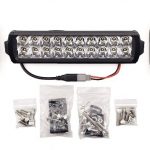No doubt you don’t mean any harm to your dog or cat when you own a large assortment of houseplants. The purpose is to provide some added beauty to the home, not to threaten the health of your favorite critter.
However, unwittingly you may be threatening the health of your dog or cat with particular houseplants you have on a windowsill, table or counter. You may not know it, but some of the most popular plants grown in the home can present a danger.

The begonia is a beautiful plant that will perk up the indoors of any home. However, it is one of many houseplants that are toxic for dogs and cats.
(Courtesy: Pancy Siam at flickr.com)
What follows is a list of 18 common and popular houseplants that can present a problem for your pet.
· Aloe. It may lend a decorative touch to the room and have the added benefit of providing relief if you suffer a burn, but it is one of many houseplants that threaten your dog or cat.
· Asian Lily. You may be tempted to show off this plant in your home during Easter when many retail stores sell them. Its colors including pink, yellow and white are definitely festive. Still, they can be a problem for cats and dogs.
· Asparagus Fern. Although this houseplant sports a lush green color that offers just the right hue addition to your home, it too can mean trouble to your dog or cat.
· Begonia. This houseplant may be ideal for parts of your home that are dark because it doesn’t need much light. Still, yes, this too can be a danger for Rover or Cleopatra.
· Bird of Paradise. This houseplant is an ideal tropical tree for growing indoors and offer great blooms. However, this also is a threat to your pet.
· Branching Ivy. Also known as English Ivy, this houseplant requires very little maintenance and helps to purify the air. NASA has identified it as a plant that creates oxygen and offers a filter to toxins in the air that might threaten your health. However, it is toxic to your pet.
· Caladium. Also known as elephant ears, this is a big green plant that may prove ideal for a corner of a room. However, its leaves can present a problem to your dog or cat.
· Catnip. Most people think that their cat would love to have some catnip present in the house. However, believe it or not, the American Society for Prevention of Cruelty to Animals (ASPCA) says that nibbling at the plant can get your cat over stimulated causing a problem with his or her central nervous system resulting in injury.
· Cutleaf Philodendron. Also known as Ceriman and the Swiss Cheese Plant, the Cutleaf Philodendron thrives in low light and will tolerate sporadic watering. However, according to the ASPCA, this species of Philodendron presents a danger to dogs and cats.
· Cornstalk Plant. Also known as the corn plant, dracaena, dragon tree, and ribbon plant, it is also identified by NASA as a houseplant that helps to purify indoor air. However, ASPCA advises that you forego this if you own a pet.
· Fig Tree. This houseplant is known to offer fruit even if grown indoors because the flowers don’t need to be pollinated. However, yes, fig trees are toxic to dogs and cats too.
· Golden Birds Nest. Also known as the snake plant, mother-in-law’s tongue, and good luck plant, it requires very little maintenance, thrives in low light and is hard to kill. In fact, the houseplant can go for a month without water. But, this is another plant that the ASPCA cautions owners of a dog or cat against.
· Golden Pothos. Also known as devil’s ivy, taro vine, and ivy arum, it is incredibly easy to grow. This houseplant, like the Golden Birds Nest, is tough to kill. It is so easy to grow that the tropical vine trail can achieve up to 10-feet indoors. Still, it too is trouble for dogs and cats.
· Jade Plant. This houseplant thrives on very little water and is easy to grow. It is available in a number of different varieties, one or more of which will attract your favor. However, it is not one that is a favorite of pets because it too is toxic.
· Lemon Tree. Ideal in a sunny corner of a home, if pollinated it offers fruit and a wonderful smell. However, it’s a danger for your dog or cat.
· Octopus Tree. Also known as the umbrella plant or starleaf, this houseplant is available in a number of different sizes. There are tiny ones you can put on a desk or large ones that thrive in bright, indirect sunlight. However, don’t consider buying one if you have a dog or cat.
· Peace Lily. This houseplant offers white blooms, helps to clean the air, and thrives in less than the best light. In fact, it does well in places with no windows and has fluorescent lights. Still, it is not a good plant to have if you own a dog or cat.
· Pencil Cactus. Easy to care for, this houseplant will survive well if under watered. However, it means trouble for your dog or cat.






